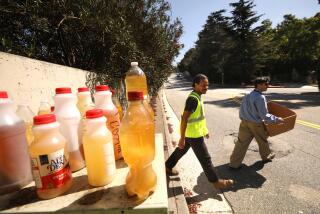Public Toilets Create a Stink in S.F.
- Share via
SAN FRANCISCO — The police listened. They eavesdropped and double-checked. And they decided that whatever users were doing inside the Tenderloin district public pay toilet at night, they certainly weren’t going to the bathroom.
“Not one flush,” said Supervisor Gavin Newsom. “The police watched for weeks and nobody inside that toilet at night used it for the purpose it was designed for.”
After-dark street denizens were selling and shooting up heroin and crack cocaine in the oval kiosk. Hookers took customers there.
And some homeless people used it as an urban campsite, according to a police.
Now officials want to close eight of the city’s 25 25-cent, self-cleaning toilets each night to discourage the criminals they attract.
The toilets, most of which were installed six years ago, have a spotty record, officials say. Though praised for their convenience in tourist areas such as Fisherman’s Wharf, they have been lambasted as public nuisances in many high-crime areas.
“A third of them give us headaches: the ones in neighborhoods with their own quality-of-life problems,” said Cmdr. Greg Suhr, who heads the San Francisco Police Department’s patrol divisions. “They’re the ones we want to watch.”
Newsom last week introduced a measure to close four of the worst toilets between 11 p.m. and 6 a.m. in a six-month trial.
The move came one week after the Los Angeles City Council made a deal allowing the Franco-American consortium Infinity Decaux to provide 150 of the sleek kiosks in exchange for the right to put 3,200 advertising signs on and around them. The deal is similar to one made with San Francisco officials in 1995.
When told of the San Francisco police study, Los Angeles City Councilman Dennis Zine said the results didn’t surprise him. Zine opposed the L.A. toilet deal, he said, until a trip to San Francisco last summer convinced him that the plan could work.
He knows the toilets do not come without problems.
“I understand about drugs and prostitution,” he said. “And in many areas, we’re going to need added police patrols and make sure these toilets don’t get out of hand.”
The manufacturer, JCDecaux, says the forest-green lavatories, now in 550 cities worldwide, get a bad rap. Company officials say drug and prostitution problems existed long before pay toilets.
San Francisco officials concede that the problems are largely in areas with high homeless populations, where many toilets have been vandalized for quarters. Cleaning crews find used condoms and spent hypodermic needles.
Newsom was dismayed by the police survey, which turned up one destitute woman who considered a downtown pay toilet her home.
“Another person was using the toilet as an office,” the supervisor said. “People were selling drugs and turning tricks there. We’ve found syringes and heroin balloons. This is about as bad as it gets.”
Suhr said police monitored eight toilets overnight for three weeks in early November: “None of the toilets had over three flushes in that time frame,” Suhr said.
One homeless man told officers that he “would rather go behind a tree than use one of those [toilets],” Suhr said. “If a person who’s down on their luck is worried about the health hazards associated with using a facility designed for the disenfranchised, that means the toilets are missing their mark.”
Jake Szeto, a project manager with San Francisco’s Public Works Department, said the toilets have served 3 million users. The commodes, each a roomy 85 square feet, feature a seat that retracts into the wall where it is automatically washed and dried after each use. The sink and soap dispensers work by motion detectors. The sliding door reopens after 20 minutes.
“It’s not the toilets that are the problem; it’s the locations,” Szeto said. He said a problem toilet at the corner of 6th and Mission streets will be moved.
Though Zine will not request any toilets for his West San Fernando Valley district, he hopes they help many of the city’s poorer areas.
“I saw a person defecate on the sidewalk along Highland Avenue in the middle of the afternoon,” he said. “You go in some alleys in the downtown area, the stench of urine is so overwhelming it’s ridiculous. It’s a health hazard. We’ve got to do something about it.”
San Francisco officials have some advice for their Los Angeles brethren.
“These toilets can drain an enormous amount of police resources,” Newsom said.
“Residents should be informed of what they’re getting themselves into.”
More to Read
Sign up for Essential California
The most important California stories and recommendations in your inbox every morning.
You may occasionally receive promotional content from the Los Angeles Times.














